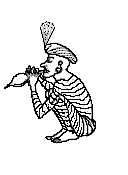 | ||
Stage or street magic has a long history in India. Popular tricks include the rope trick, Indian basket, and Indian cups and ball.
Contents
Modern history
The Latin term Magi was used to refer to Zorastrians during ancient times. The performance of magic and its practice is historical and very ancient. There would be definite yet varied purposes for the practice of magic which evolved where entertainment, tricks, deception, illusion, cheating in games, and fun may have been aimed. Sometimes, in religious context and purpose, it meant to offer social education along with some kind of preaching and healing too. The practice of Magic started to become evident around the beginning of the 18th century in India, and eventually the nation would present some distinct magicians in later years. West Bengal, Kerala, Karnataka, Gujarat, Delhi, Mumbai, Andhra Pradesh and some other parts of India have produced few great magicians so far.
P.C. Sorcar is known as the father of modern Indian magic. Some of his specialties included: Sawing a woman in half and Aerial Suspension illusion. He was a prolific author of books on magic in Hindi, Bengali and English languages.
Ancient history
In ancient times, Indian magicians were often considered to be workers of legitimate mystical miracles, not simply entertainers. The general reputation of Mohammed Chhel, born in 1850 in Ningala, Bhavnagar, Gujarat is notable in the magic world. Very popular regionally, he was considered a Mystic. Chhel did not generally venture into stage shows and commercial performances. His target audience remained peasants, simple - ordinary people, villagers, train passengers and such a class of society. With his performance/acts he often intended to convey some message of life to people, and he would strive to extend with his acts/magic for the benefit of deprived people. There are also several other popular magicians and their groups in Gujarat, such as one more big name of K Lal, Pro. Chudasama, and few others.
The grandfather of Kerala's magic is Vazhakunnam Neelakandan Namboothiri. He played an important role in bringing magic as an art. Born in 1903, he learned magic after having watched some tricks shown in his Illam by one Mundaya Eachara Varier. Vaazhakunnam later became famous for Kayyothukkam, although occasionally he performed also "Cheppum Panthum" (cups and balls) to small family gatherings. After 1940 he started real stage performances with his troupe. Apart from magic, the shows included short dance programmes, comedy skits, etc.
Notable illusions
There is some evidence that the Aerial suspension illusion originated with an Indian Brahmin.
